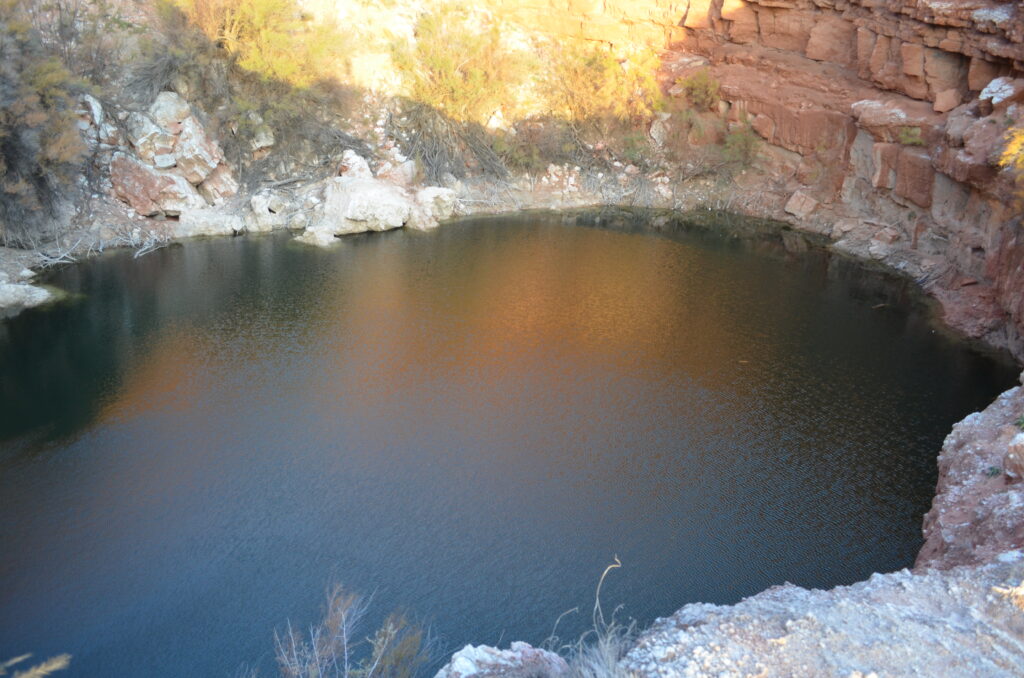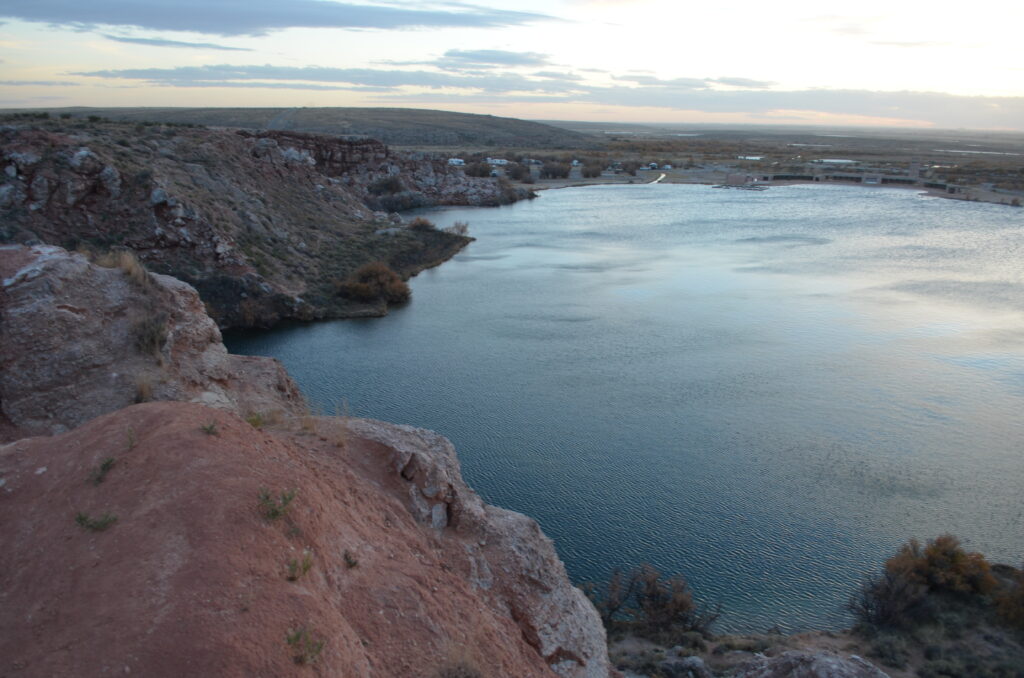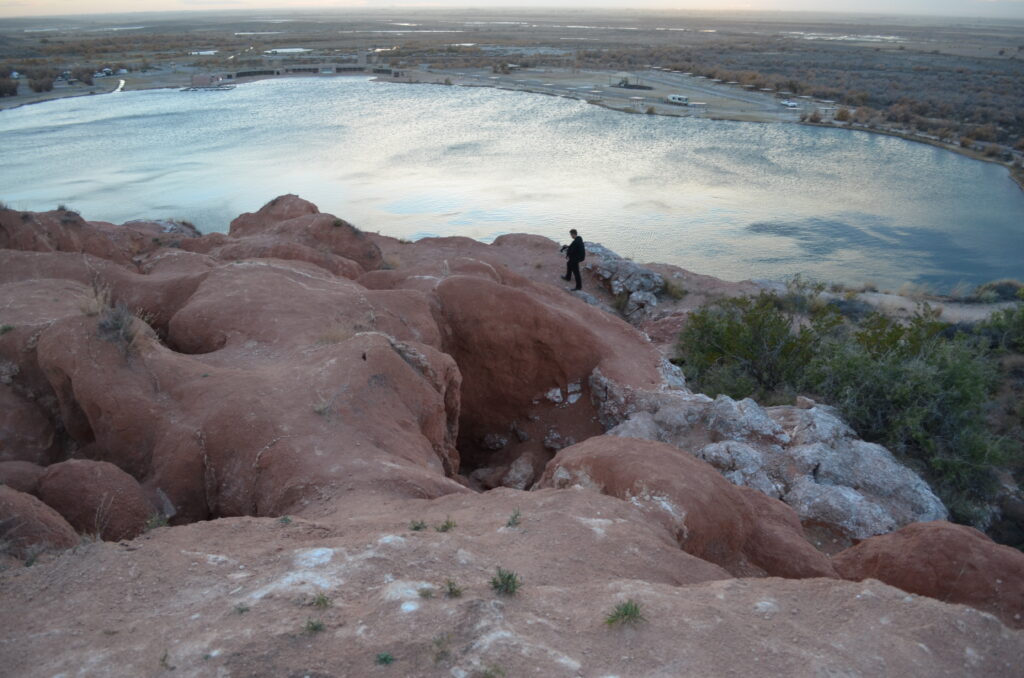
Bottomless Lakes State Park
* Roswell, New Mexico, USA *
The memories of Bottomless Lakes State Park … it was my family and friend’s swimming hole and playground while growing up in Roswell, New Mexico. Bottomless Lakes provided much cooling off during the hot and dry summers of the desert. Only Fifteen miles from Roswell, the Lakes is located along the Pecos River, and are a series of natural caves and sinkholes forming lakes used for recreation. The parks were established in 1933 and were the first State Park founded in New Mexico. There are Eleven small deep lakes along the escarpment of the Pecos River Valley that represents the remains of an ancient limestone reef. Caves formed within this limestone and eventually collapsed via erosion creating sinkholes or “cenotes” as round circular lakes or swimming holes. One of the largest lakes in Lea Lake and Lazy Lagoon, providing a large sandy shoreline that outdoor recreational visitors can use for picnicking, camping, outdoor sports, and swimming. Lazy Lagoon is the largest of the lakes and spans over 26 acres as a single lake but is made up of three interconnected sinkholes. The lagoon is level with the salt flats which gives it an appearance of being very shallow, where in contrast, it is actually quite deep – over 90 feet deep. As opposed to the old days, Lea Lake is the only lake in which swimming is allowed, due to accidents that occurred in the others, especially Devil’s Inkwell.

The shallowest is Pasture Lake with a depth of 18 feet and a surface of .76 acres. The deepest is Lea Lake (90 feet deep – only one that allows swimming) and Lazy Lagoon (90 feet/ 26 acres). The smallest of the lakes is the darkest, known for its color, steep sides, and algae growth, called “the Devil’s Inkwell” and is approximately .36 of an acre. Figure 8 Lake is actually two lakes separated by a thin beach that seasonally gets covered making it look like one lake at times. The circular shapes connecting create the figure 8 symbol. Cottonwood Lake is 30 feet deep, and Mirror Lake at 50 feet. The Lakes are fed by underground streams and aquifers percolating through the rocks up into the catchment holes. The lakes are home to various endangered species and all of the park’s lakes are protected. The four known endangered species found at the park are the Cricket Frog, Eastern Barking Frog, Rainwater Killifish, and the Pecos Pupfish.
The lakes were originally visited frequently by Prehistoric Indians of the region, and in the 1500s were said to have been visited by Spanish Conquistadors searching for the legendary Seven Cities of Gold. While the Conquistadors did not record their visitation, it is said that the Native Americans drew a petroglyph at the Lakes depicting a Spanish Conquistador riding a horse according to John LeMay’s book “Legends and Lore of Bottomless Lakes” has also appeared in the Roswell New Mexico Centennial Magazine as well.
According to legend, the lakes got their name as “Bottomless” because the outlaw Billy the Kid and his gang who once hid out in the bluffs supposedly dipped their ropes in one lake to see how deep it was and they didn’t hit bottom so called it “Bottomless”. The deepest lake is Leah Lake at 90 feet.
There are numerous legends surrounding the lakes from an Octopus Man, giant turtles, giant catfish, a White Ghost Horse, and a Dragon. There are many legends of people drowning in the muddy depths and being transported by an Underground Artesian river and cave system to Carlsbad Caverns, giant turtles eating people who went missing there, sheep and horses reportedly been swallowed by the lakes and numerous cars. The only evidence of such legends are remnants of cars at the bottom. Some say atop the cliffs and bluffs of the lake, teens had drag-raced and lost their cars over the edges into the lakes. A local boater claimed to have seen a giant turtle surface in the 1980’s large enough to claim Nessie was in the lake and that it came to eat him.
Rating: 5 stars out of 5. ~ Thomas Baurley and Leaf McGowan.

The Eleven lakes are:
- Lazy Lagoon – one of the two deepest at 90 feet with a 26.1-acre surface area.
- Cottonwood Lake – 27.5 feet deep with .52 acres of surface area and having natural shade over it.
- Mirror Lake North – 32.8 feet deep with 3 acres of surface area.
- Mirror Lake south – 43.3 feet deep, .44 acre surface area.
- Devil’s Inkwell – 28.2 feet deep, .36 acre surface area, has dark algae in it that makes it appear darker than others.
- Figure 8 Lake North – 37 feet deep, 1.46-acre surface area. Forms a figure 8 with Figure 8 Lake South, but is an independent lake.
- Figure 8 Lake South – 22 feet deep, .76 acre surface area. Forms a figure 8 with Figure 8 Lake North, but is an independent lake.
- Pasture Lake – 18 feet deep, the shallowest of the lakes, having a .76 surface area.
- Lost Lake – The depth is unknown, and has a surface area of .1 acre.
- Lea Lake: the deepest of the lakes with a maximum depth of 90 feet, 2nd largest in acreage at 15 acres surface area. The only lake where swimming is currently allowed and hosts a daily spring flow of 2.5 million gallons.
- Dimmit Lake – unknown depth, made up of two basins covering 10 acres, is privately owned.
More Information:
- http://mysteriousuniverse.org/2016/03/exploring-american-monsters-new-mexico/
- http://www.focusnm.com/roswell/monsters-spooks-roswell-southeast-new-mexico/
- http://wheninyourstate.com/new-mexico/theres-something-magical-about-these-11-lakes-in-roswell-new-mexico/




















